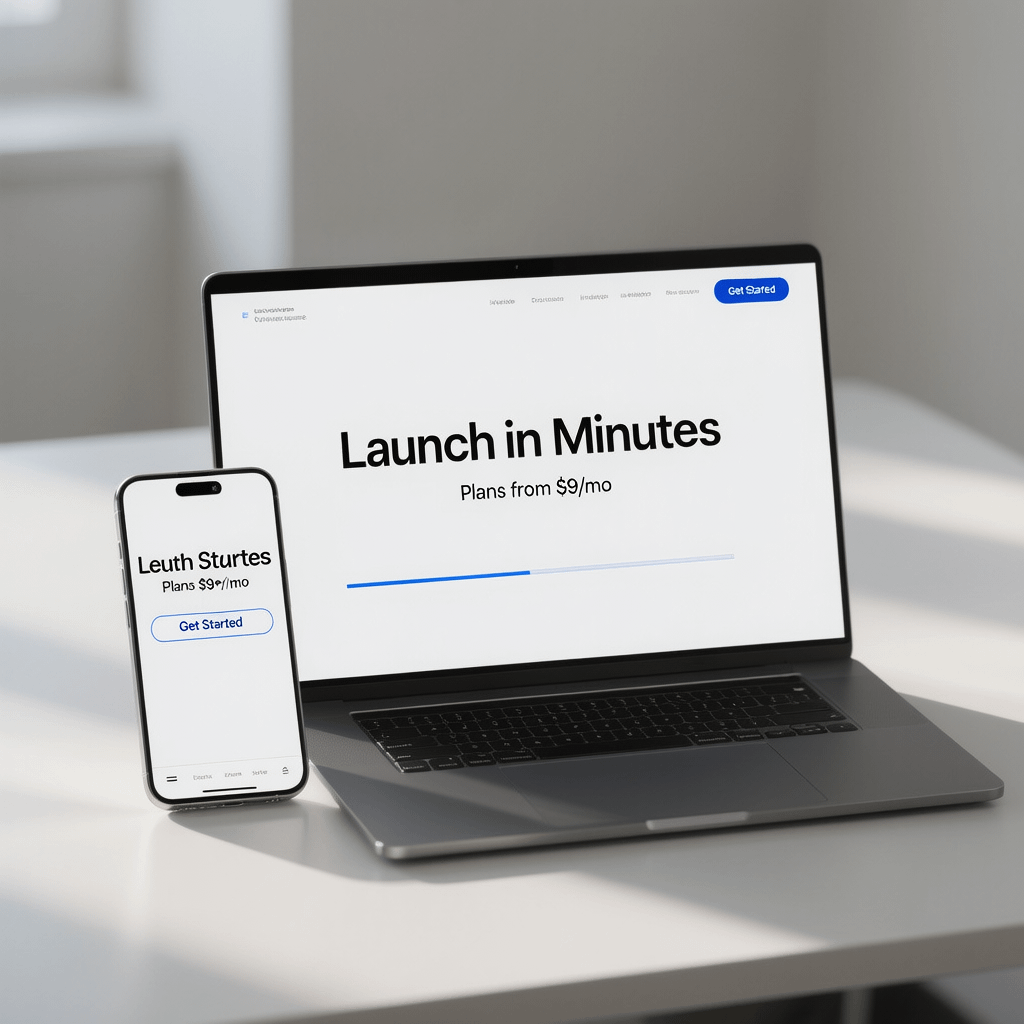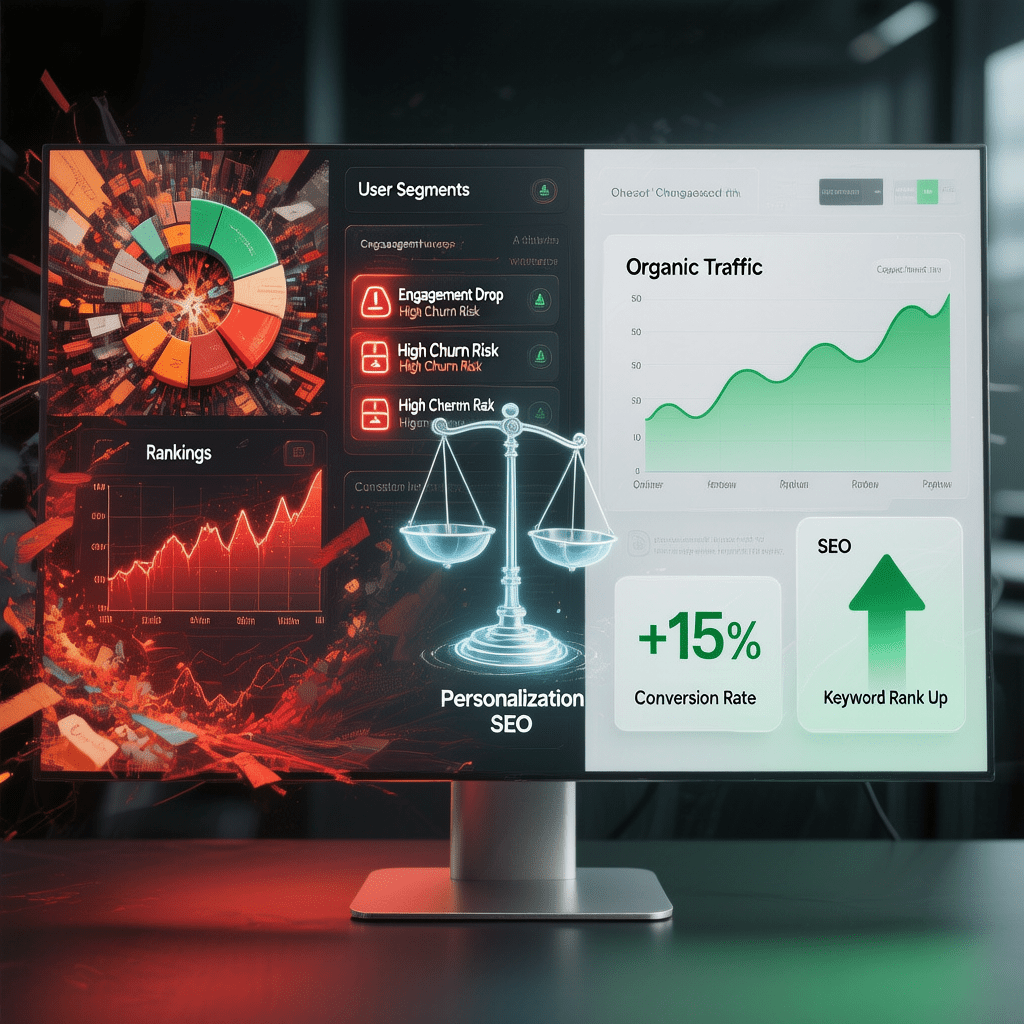
The critical balance between personalization benefits and SEO risks
9 Personalization SEO Risk Factors That Tank Your Rankings
The personalization SEO risk hiding in your website could be destroying your rankings right now. While 80% of consumers prefer personalized experiences, implementing personalization wrong causes catastrophic SEO damage that takes months to recover from.
You’ve invested thousands in personalization technology to boost conversions. But what if that same technology is secretly sabotaging your organic traffic? Studies show that poorly implemented personalization can drop organic visibility by up to 68% within weeks.
The conflict between personalization and SEO creates a dangerous balancing act. Get it right, and you’ll dominate both user experience and search rankings. Get it wrong, and you’ll watch competitors steal your traffic while you scramble to understand what went wrong.

Understanding the Personalization SEO Risk Landscape
Personalization promises increased engagement, higher conversions, and improved customer satisfaction. Yet Google’s crawlers don’t experience your site like humans do. They see a completely different version – one that might be broken, duplicated, or completely invisible.
The fundamental problem stems from a simple fact: search engines need consistent, crawlable content to understand and rank your pages. Personalization, by definition, creates variable content experiences. This contradiction forms the core of personalization SEO risk.
Consider what happens when you show different content to different users. Google’s crawler might see generic content while your visitors see highly targeted messages. Or worse, the crawler might see nothing at all if your personalization blocks access. Either scenario devastates your rankings.
The 9 Critical Personalization SEO Risk Factors
After analyzing hundreds of personalization implementations, we’ve identified nine risk factors that consistently destroy SEO performance. Understanding these dangers helps you avoid the pitfalls that trap most marketers.
1. Duplicate Content Multiplication
Personalization often creates multiple URL variations for similar content. Location-based personalization might generate separate URLs for each city, creating thousands of near-duplicate pages. Google penalizes this duplication severely.
The problem compounds when personalization parameters appear in URLs. Session IDs, user preferences, and tracking parameters create infinite URL variations of the same page. Search engines waste crawl budget on these duplicates while missing your important content.
Dynamic content generation makes matters worse. When personalization engines create slightly different versions for each visitor segment, you’re essentially publishing dozens of similar pages. Google’s algorithm interprets this as low-quality, thin content.
The solution requires careful URL structure planning. Implement canonical tags religiously, use URL parameters correctly in Google Search Console, and ensure personalization happens through JavaScript rather than URL changes.
2. Crawlability and Indexing Nightmares
Search engine crawlers often can’t access personalized content. JavaScript-heavy personalization frameworks frequently fail to render for Googlebot, leaving crawlers viewing blank pages or default placeholders instead of your optimized content.
Server-side personalization creates different problems. When your system detects Googlebot’s user agent and serves different content, you’re accidentally implementing cloaking – a serious violation of Google’s guidelines that triggers manual penalties.
Progressive rendering techniques cause additional issues. Content that loads after user interactions or scroll events remains invisible to crawlers. Your most valuable personalized content might never get indexed.
Testing crawler access becomes critical. Use Google’s Mobile-Friendly Test and Rich Results Test to verify what crawlers actually see. Implement dynamic rendering carefully, ensuring crawlers receive complete content without triggering cloaking concerns.
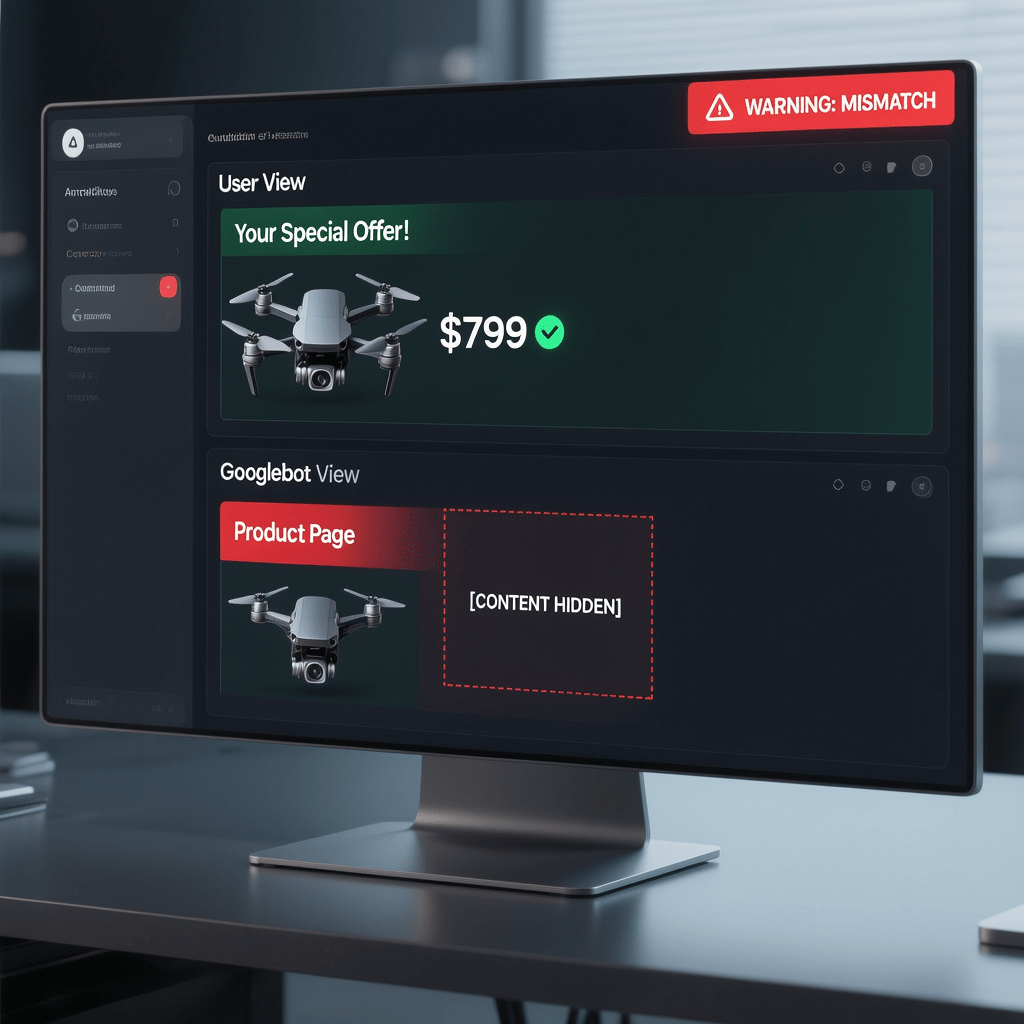
3. Page Speed Degradation
Personalization engines add significant overhead to page loading. Third-party personalization scripts, API calls, and dynamic content generation can add 2-5 seconds to load times. Since page speed directly impacts rankings, this performance hit damages SEO.
Client-side personalization requires loading base content, then processing user data, making decisions, and finally rendering personalized elements. This multi-step process creates cumulative delays that frustrate users and search engines alike.
Server-side personalization seems faster but often requires complex caching strategies. Cache invalidation for personalized content becomes nearly impossible, forcing dynamic generation for every request. This server load translates to slower response times.
The impact multiplies on mobile devices. Personalization scripts that run smoothly on desktop can cripple mobile performance. With mobile-first indexing, these mobile performance issues directly hurt your rankings.
4. Content Fragmentation and Diluted Authority
Personalization fragments your content across multiple variations, diluting the SEO authority of each piece. Instead of one strong page earning backlinks and rankings, you have dozens of weak variations competing against each other.
Link equity suffers when personalized URLs receive backlinks. External sites might link to personalized versions with session parameters or user preferences. These links don’t consolidate to your canonical URL, wasting valuable link authority.
Internal linking becomes chaotic with personalization. Automated recommendations and dynamic navigation create unpredictable link patterns. Search engines can’t understand your site structure when internal links constantly change.
Content consistency disappears when different users see different information. Search engines expect stable content they can trust. Constantly shifting personalized content signals low quality and reliability to ranking algorithms.
5. Cloaking Violations and Penalties
Accidental cloaking represents the most severe personalization SEO risk. When Googlebot receives different content than users, you violate Google’s Webmaster Guidelines. Penalties for cloaking can remove your site from search results entirely.
IP-based personalization frequently triggers cloaking concerns. Serving different content based on geographic location might seem harmless, but when Google’s crawlers receive different content than users in those locations, you’re cloaking.
User-agent detection for personalization creates similar problems. Mobile personalization that detects device types might accidentally serve different content to Googlebot’s mobile crawler. This discrepancy triggers algorithmic or manual penalties.
A/B testing through personalization platforms compounds the risk. When test variations serve different content to different users, ensuring Googlebot consistently sees the same version becomes challenging. Inconsistent crawler experiences raise red flags.
6. Structured Data Conflicts
Personalized content often conflicts with structured data markup. When your JSON-LD says one thing but personalized content shows another, search engines lose trust in your structured data. This kills your chances for rich snippets and featured results.
Product schema becomes problematic with personalized pricing. If your structured data shows one price but personalization displays location-based pricing, Google might flag your markup as misleading. This can result in manual actions against your site.
Event schema faces similar challenges with personalized dates or locations. Local personalization that changes event details based on user location creates mismatches between structured data and visible content.
The solution requires careful separation of personalized and static elements. Structured data should reflect the canonical version of content, with personalization clearly distinguished as user-specific modifications.
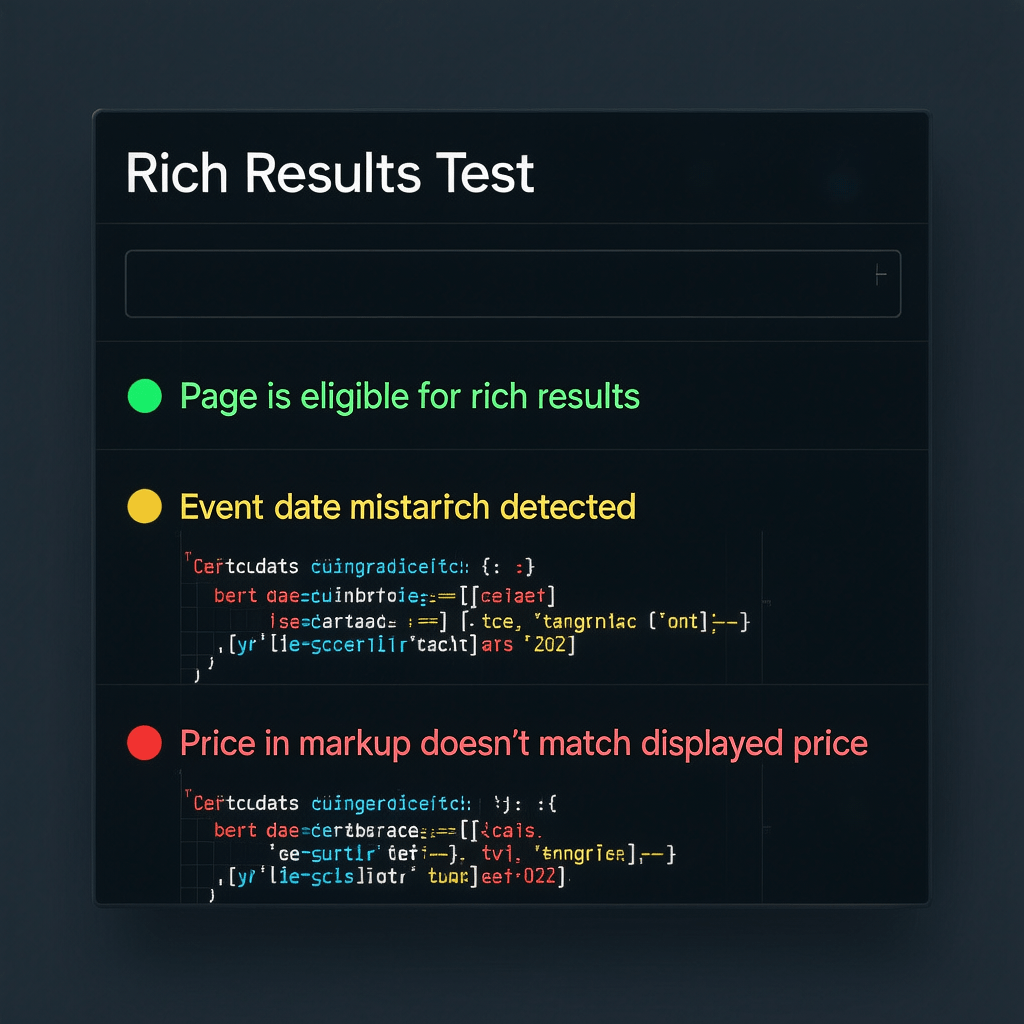
7. Analytics and Tracking Corruption
Personalization corrupts SEO metrics and analytics data. When different users see different content, measuring organic performance becomes nearly impossible. You can’t optimize what you can’t accurately measure.
Conversion attribution breaks down with personalization. A user might enter through organic search but convert on personalized content. Standard analytics attributes this to personalization, not SEO, skewing your understanding of channel performance.
Bounce rate metrics become meaningless when personalized content loads after initial page load. Users might engage with personalized elements, but analytics records a bounce because the initial pageview lacked interaction.
Keyword performance tracking fails when personalized content doesn’t match ranking keywords. Your page might rank for specific terms, but personalization changes the content to something unrelated, creating a disconnect between search intent and user experience.
8. Mobile-First Indexing Complications
Mobile-first indexing amplifies personalization SEO risk. Google primarily uses the mobile version of your content for indexing and ranking. If personalization works differently on mobile, you’re optimizing for the wrong experience.
Responsive design conflicts with personalization create indexing issues. When personalization changes layout or content structure on mobile, Google’s mobile crawler sees an inconsistent experience that damages rankings.
App deep linking personalization causes additional problems. When mobile users get redirected to apps with different content, Google can’t properly index your mobile web experience. This gap in mobile content hurts overall rankings.
Progressive web app (PWA) personalization introduces new risks. Service workers that cache personalized content can serve the wrong version to crawlers, creating indexing inconsistencies that impact rankings.
9. Privacy Regulations and SEO Impact
Privacy laws like GDPR and CCPA add another layer of personalization SEO risk. Consent requirements can block personalization for many users, creating wildly different experiences that confuse search engines.
Cookie consent banners already impact SEO by shifting content and blocking interaction. When personalization depends on consent, you’re essentially maintaining two different websites – one personalized, one not.
Data retention limits force regular content changes. When personalization data expires, returning users see different content. This instability signals low quality to search engines monitoring content consistency.
Geographic restrictions on data processing affect global SEO. If personalization works differently across regions due to privacy laws, maintaining consistent international rankings becomes nearly impossible.
Real-World Personalization SEO Disasters
Learning from others’ failures prevents repeating their mistakes. These real-world examples demonstrate how personalization SEO risk manifests in practice.
A major e-commerce site implemented location-based personalization that created unique URLs for 10,000 cities. Within two months, organic traffic dropped 71%. Google spent its entire crawl budget on duplicate location pages, ignoring new products and important category updates.
A news publisher used personalization to show different article recommendations. Their implementation accidentally blocked Googlebot from accessing article content beyond the first paragraph. Rankings disappeared overnight, taking six months to recover after fixing the issue.
A SaaS company personalized their homepage based on industry vertical. Different versions showed completely different content, triggering a manual cloaking penalty. The site disappeared from search results for three months while they appealed and rebuilt their personalization strategy.
A travel website personalized prices based on user history and location. Google’s structured data monitoring detected price mismatches, resulting in removal of rich snippets. Organic CTR dropped 43% without the enhanced SERP features.
Technical Implementation Strategies to Minimize Risk
Safe personalization requires careful technical implementation. These strategies help you achieve personalization benefits while protecting SEO performance.
Client-Side vs Server-Side Personalization
Client-side personalization offers the safest SEO approach. Load complete, optimized content first, then apply personalization through JavaScript after page load. This ensures crawlers always see your full content.
Implement progressive enhancement principles. Start with a fully functional, SEO-optimized experience. Layer personalization on top without breaking the base experience. If JavaScript fails, users and crawlers still see valuable content.
Use the Intersection Observer API for efficient client-side personalization. Load personalized elements only when they enter the viewport, reducing initial page load impact while maintaining crawlability.
Server-side personalization requires more caution but offers better performance. Implement edge-side includes (ESI) or similar technologies to cache base content while personalizing specific components. This balances performance with SEO safety.
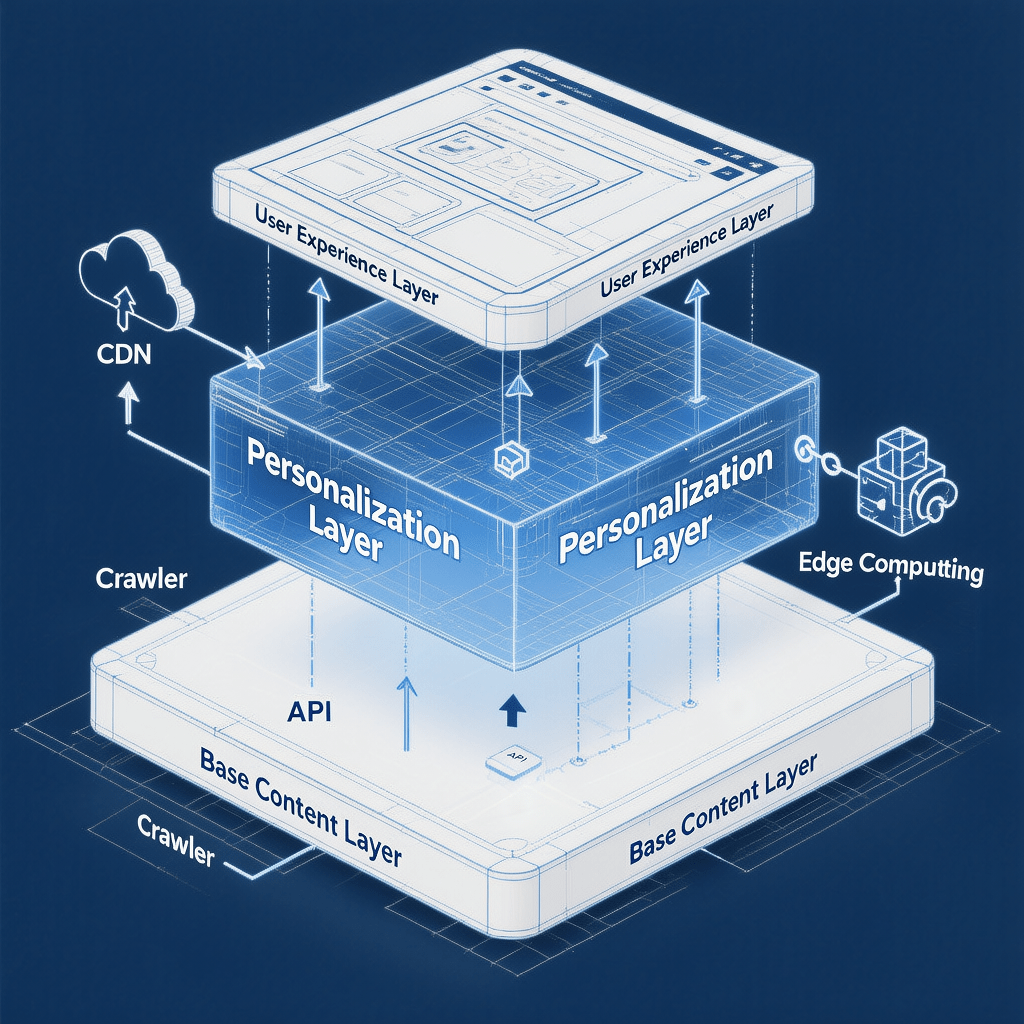
URL Structure and Parameter Handling
Maintain clean, consistent URLs regardless of personalization. Never include personalization parameters in URLs that create duplicate content. Use fragment identifiers (#) or session storage for personalization state.
Implement proper canonical tags on every personalized variation. Point all versions to a single, authoritative URL. This consolidates ranking signals and prevents duplicate content issues.
Configure Google Search Console URL parameters correctly. Tell Google how to handle any parameters that must appear in URLs. Specify whether parameters change content or are purely for tracking.
Use robots.txt carefully with personalized URLs. Block crawler access to infinite parameter combinations while ensuring important content remains accessible. Regular expression patterns help manage complex URL structures.
Content Delivery and Caching Strategies
Implement intelligent caching that balances performance with personalization. Cache base content aggressively while generating personalized elements dynamically. Use cache keys that consider both content and user segments.
Deploy content delivery networks (CDNs) that support personalization. Modern CDNs offer edge computing capabilities for personalization without sacrificing cache efficiency. This maintains fast global performance.
Use cache warming strategies for popular personalization combinations. Pre-generate common personalizations during off-peak hours. This improves performance without compromising SEO or user experience.
Implement fallback mechanisms for personalization failures. When personalization systems fail, serve SEO-optimized default content rather than errors. This ensures crawlers always see valuable content.
Testing and Monitoring Personalization SEO Impact
Continuous testing and monitoring detect personalization SEO risk before damage occurs. Implement comprehensive testing protocols that catch issues early.
Pre-Launch Testing Protocols
Test crawler access thoroughly before launching personalization. Use Google’s testing tools to verify what crawlers see. Compare crawler views with user experiences to identify discrepancies.
Conduct load testing with personalization enabled. Measure impact on page speed and server response times. Set performance budgets that prevent personalization from degrading SEO metrics.
Validate structured data with personalized content. Ensure schema markup remains accurate regardless of personalization. Test rich snippet eligibility across different personalized versions.
Run cloaking detection tests using various user agents and IPs. Verify that content remains consistent for crawlers regardless of detected attributes. Document any intentional variations and their justification.
Ongoing Monitoring Systems
Implement real-time monitoring for SEO metrics. Track rankings, organic traffic, and crawl stats daily. Set alerts for sudden changes that might indicate personalization problems.
Monitor Core Web Vitals with personalization active. Track Largest Contentful Paint, First Input Delay, and Cumulative Layout Shift. Ensure personalization doesn’t push metrics below acceptable thresholds.
Use log file analysis to understand crawler behavior. Analyze how Googlebot interacts with personalized content. Identify crawl inefficiencies or access problems that need addressing.
Track indexation rates for personalized pages. Monitor how many personalized URLs get indexed versus canonical versions. Rapid growth in indexed personalizations signals duplicate content issues.
Building SEO-Safe Personalization Frameworks
Creating frameworks that support both personalization and SEO requires thoughtful architecture. These principles guide development of sustainable personalization systems.
Component-Based Personalization Architecture
Design personalization as modular components rather than page-level changes. This allows precise control over what gets personalized while maintaining stable SEO foundations.
Separate content into SEO-critical and personalizable sections. Keep title tags, meta descriptions, and main content stable. Personalize supplementary elements like recommendations, CTAs, and imagery.
Implement personalization zones with clear boundaries. Define specific page areas where personalization occurs. This prevents personalization from accidentally affecting SEO-critical elements.
Use web components or similar technologies for encapsulation. Isolated personalization components prevent CSS and JavaScript conflicts that could break SEO elements.
Data Layer Separation
Maintain strict separation between SEO content and personalization data. Store personalization preferences in user sessions or cookies, not in URLs or page content.
Implement a unified data layer that both SEO and personalization systems access. This ensures consistency while allowing independent optimization of each system.
Use event-driven architectures for personalization triggers. This decouples personalization logic from page rendering, maintaining clean, crawlable HTML.
Design APIs that serve both crawlers and personalization engines. Provide consistent base content with optional personalization overlays based on request context.
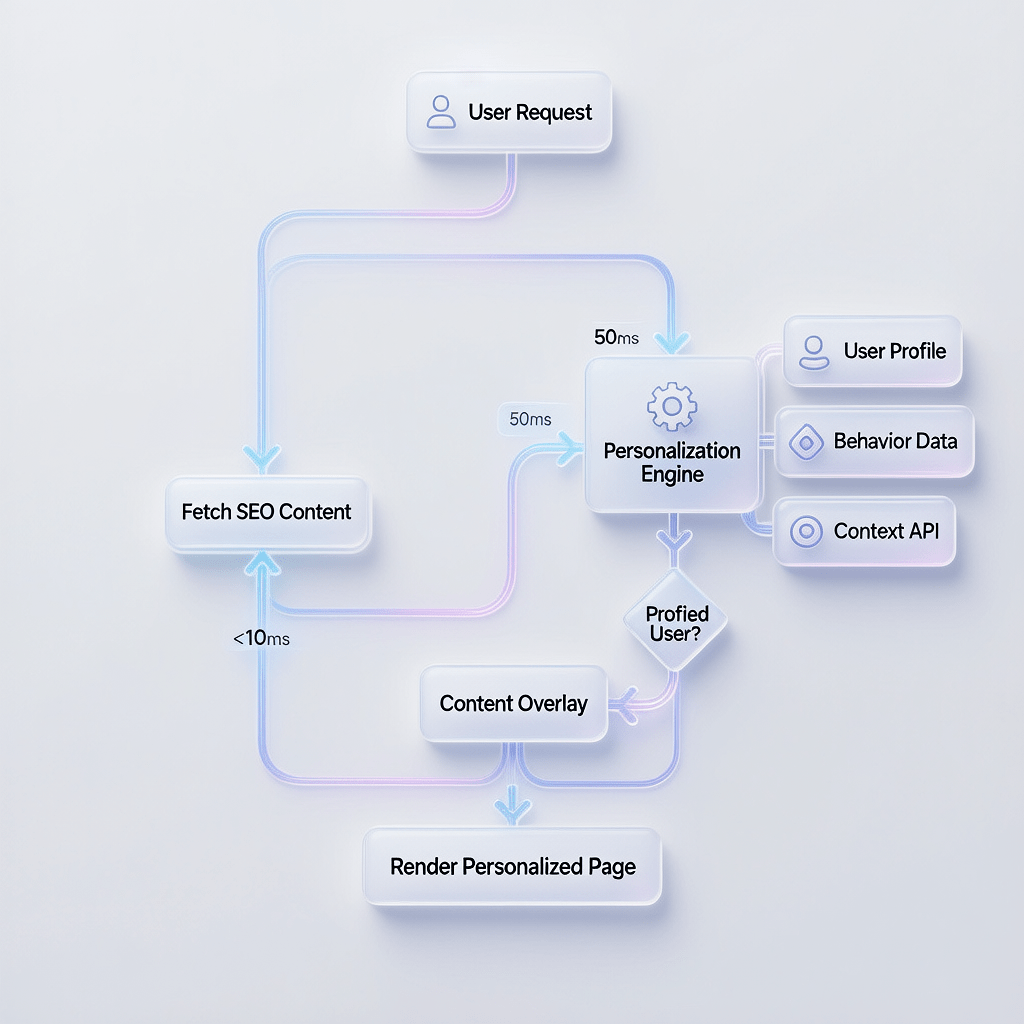
Industry-Specific Personalization SEO Considerations
Different industries face unique challenges when balancing personalization with SEO. Understanding sector-specific risks helps tailor your approach.
E-commerce Personalization Challenges
E-commerce sites face intense pressure to personalize product recommendations, pricing, and promotions. Yet these same elements are crucial for SEO. Product pages need stable content for rankings while showing personalized recommendations.
Dynamic pricing personalization creates structured data nightmares. Search engines expect consistent pricing in schema markup. Personalized prices that don’t match structured data trigger trust issues and potential penalties.
Category page personalization poses particular risks. Changing product order or filtering based on user behavior can make category pages uncrawlable. Maintain a stable default view while personalizing secondary elements.
Shopping feed optimization conflicts with on-site personalization. Google Shopping requires accurate product data that matches landing pages. Personalization that changes product information creates feed mismatches.
Publishing and Media Sites
Content publishers must balance editorial SEO with personalized article recommendations. Changing article headlines or excerpts based on user interests risks keyword optimization and featured snippet eligibility.
Paywall personalization creates unique challenges. Showing different content access levels to different users can trigger cloaking concerns. Ensure Googlebot sees the same content as first-time visitors.
Related content algorithms affect internal linking patterns. Personalized recommendations that constantly change prevent search engines from understanding content relationships and site architecture.
AMP implementation complicates personalization further. Accelerated Mobile Pages have strict limitations on JavaScript, restricting personalization options while requiring consistent content for indexing.
B2B and SaaS Websites
B2B sites personalizing by company size, industry, or role face specific SEO challenges. Creating multiple content versions for different audiences fragments SEO authority and creates duplicate content.
Account-based marketing (ABM) personalization often conflicts with SEO. Showing completely different homepages to target accounts versus organic visitors raises serious cloaking concerns.
Gated content personalization impacts crawlability. If personalization determines what content requires registration, ensure crawlers can access enough content for proper indexing.
Multi-language personalization based on IP location can hurt international SEO. Use proper hreflang tags and allow user language selection rather than forcing personalized language versions.
Advanced Techniques for Personalization Without SEO Risk
Sophisticated approaches enable powerful personalization while maintaining SEO integrity. These advanced techniques require technical expertise but deliver superior results.
Edge Computing and Personalization
Edge computing enables personalization closer to users without affecting origin servers. This maintains fast, consistent crawler experiences while delivering personalized content to users.
Implement Cloudflare Workers or similar edge functions for personalization. Process personalization logic at edge locations, reducing latency while keeping origin content stable for SEO.
Use edge-side includes for component-level personalization. Cache base pages centrally while personalizing specific components at the edge. This balances performance with SEO requirements.
Deploy geo-distributed personalization logic to minimize latency. Process personalization decisions close to users while maintaining centralized SEO content management.
Machine Learning and Predictive Personalization
Machine learning enables smarter personalization that anticipates user needs without compromising SEO. Predictive models can enhance user experience while maintaining crawlable content.
Implement collaborative filtering that doesn’t affect URLs. Generate recommendations based on user behavior patterns without creating duplicate pages or URL parameters.
Use natural language processing to personalize content tone without changing keywords. Adjust writing style and complexity while maintaining SEO-critical terms and structure.
Deploy reinforcement learning for personalization optimization. Continuously improve personalization effectiveness while monitoring SEO impact, automatically adjusting when rankings decline.
API-First Personalization Architecture
API-driven personalization separates content delivery from personalization logic. This maintains clean, crawlable HTML while enabling sophisticated personalization through APIs.
Implement GraphQL for flexible content queries. Serve consistent base content to crawlers while allowing personalized queries for user experiences.
Use webhook-based personalization updates. Trigger personalization changes through events rather than modifying page content, maintaining stable crawlable pages.
Deploy headless CMS architecture with personalization layers. Separate content management from presentation, allowing personalization without affecting source content.
Recovery Strategies for Personalization SEO Damage
When personalization has already damaged SEO, swift recovery action is essential. These strategies help restore rankings while maintaining personalization benefits.
Identifying and Diagnosing SEO Damage
Start with comprehensive SEO audits to identify personalization-related issues. Use Google Search Console to find indexing problems, crawl errors, and ranking drops coinciding with personalization launches.
Analyze server logs to understand crawler behavior. Look for patterns indicating crawlers receive different content or encounter errors. Compare crawler sessions with user sessions to identify discrepancies.
Review indexed pages for personalization parameters. Search for site:yourdomain.com with various parameters to find duplicate indexed content. Document all variations for cleanup.
Check for manual actions or algorithmic penalties. Review Google Search Console for cloaking warnings or thin content issues. Monitor ranking patterns for signs of algorithmic suppression.
Immediate Remediation Steps
Implement emergency fixes to stop ongoing damage. Temporarily disable problematic personalization while maintaining user experience through safer alternatives.
Add canonical tags to all personalized variations immediately. Point duplicates to canonical versions to consolidate ranking signals. Use dynamic canonical tag generation for scalability.
Submit updated sitemaps excluding personalized URLs. Include only canonical versions to guide crawlers toward correct content. Remove personalized URLs from existing sitemaps.
Configure robots.txt to block problematic personalization patterns. Prevent crawlers from accessing infinite URL variations while keeping important content accessible.
Long-Term Recovery Planning
Develop comprehensive recovery strategies addressing root causes. Redesign personalization architecture to prevent future issues while restoring lost rankings.
Gradually migrate from server-side to client-side personalization. This eliminates cloaking risks while maintaining personalization benefits. Phase migration to minimize user experience disruption.
Implement proper 301 redirects from personalized to canonical URLs. Consolidate link equity from scattered personalized pages. Monitor redirect chains to prevent loops.
Rebuild internal linking with stable, non-personalized URLs. Create consistent site architecture that search engines can understand. Use JavaScript for personalized navigation overlays.
Future-Proofing Your Personalization SEO Strategy
Search engines continuously evolve their handling of personalized content. Future-proofing your strategy ensures sustained success as algorithms change.
Preparing for AI-Powered Search
Artificial intelligence in search engines will better understand personalization intent. However, this doesn’t eliminate SEO risk. AI systems still need consistent, trustworthy content as training data.
Focus on entity-based SEO that transcends personalization. Build topical authority around core concepts rather than specific keyword variations. This maintains rankings regardless of personalization.
Implement semantic HTML that clearly distinguishes personalized elements. Use appropriate ARIA labels and schema markup to indicate dynamic content. This helps AI understand content structure.
Prepare for conversational search interfaces. Optimize for natural language queries that might bypass traditional personalization. Focus on comprehensive content that answers varied user intents.
Privacy-First Personalization
Increasing privacy regulations will restrict personalization options. Develop strategies that deliver personalized experiences without invasive tracking that could trigger penalties.
Explore contextual personalization based on content rather than user data. Personalize based on page topic, referral source, or time of day rather than personal information.
Implement privacy-preserving personalization technologies. Use differential privacy, federated learning, or homomorphic encryption to personalize without exposing user data.
Build first-party data strategies that comply with regulations. Collect data transparently with clear consent while maintaining SEO-friendly content for non-consenting users.
Measuring Personalization SEO Success
Quantifying the balance between personalization and SEO requires sophisticated measurement. Track both user engagement and search performance to optimize effectively.
Key Performance Indicators
Monitor organic traffic alongside personalization metrics. Track whether personalization improves user engagement without sacrificing search visibility. Set targets that balance both objectives.
Measure crawl efficiency to ensure personalization doesn’t waste crawler resources. Monitor crawl stats in Google Search Console, watching for increases in crawled URLs without corresponding content growth.
Track ranking distributions across personalized and non-personalized keywords. Ensure core SEO terms maintain rankings while personalized experiences improve conversion metrics.
Analyze user behavior differences between organic and personalized experiences. Compare engagement metrics to verify personalization adds value without confusing search-driven visitors.
Attribution Modeling for Personalized SEO
Develop attribution models that accurately credit both SEO and personalization. Standard models often misattribute conversions, hiding the true impact of each channel.
Implement custom dimensions in analytics for personalization variants. Track which personalizations users see alongside their entry source. This reveals how SEO and personalization interact.
Use cohort analysis to measure long-term personalization impact. Track whether personalized experiences improve retention for organically acquired users. This justifies personalization investment.
Create dashboards that visualize the relationship between personalization and SEO. Display metrics side-by-side to identify correlations and conflicts requiring attention.
Expert Implementation Support
Successfully navigating personalization SEO risk requires deep technical expertise and continuous optimization. Many businesses discover too late that their personalization strategy has devastated their organic search presence.
Brand Nexus Studios’ SEO services include specialized personalization audits that identify and eliminate SEO risks before they damage your rankings. Our technical team understands the complex interplay between modern personalization platforms and search engine requirements.
We’ve helped dozens of companies recover from personalization-induced ranking drops while maintaining their conversion optimization goals. Our approach balances user experience enhancement with search engine visibility, ensuring you don’t sacrifice one for the other.
Common Personalization Platform SEO Issues
Popular personalization platforms each present unique SEO challenges. Understanding platform-specific risks helps you make informed technology decisions.
Adobe Target and SEO Compatibility
Adobe Target’s powerful personalization capabilities often create SEO complications. The platform’s default implementation can block crawler access to test variations, limiting indexation of optimized content.
Server-side implementation of Adobe Target requires careful configuration to avoid cloaking. Ensure crawler detection doesn’t trigger different experiences that violate search engine guidelines.
The platform’s redirect tests can create URL proliferation. Multiple test URLs dilute SEO authority unless properly managed with canonicalization and redirect strategies.
Optimizely and Dynamic Content Risks
Optimizely’s client-side personalization can cause content flashing that impacts Core Web Vitals. Layout shifts during personalization hurt both user experience and SEO performance metrics.
Full stack implementations require careful crawler handling. Server-side decisions about content variation must consider search engine accessibility to avoid indexing problems.
Feature flags and gradual rollouts complicate SEO tracking. Ensure consistent experiences for crawlers while testing new personalization features with real users.
Google Optimize Sunset Impact
Google Optimize’s discontinuation forces migration to alternative platforms. This transition period presents risks as new implementations might not maintain previous SEO safeguards.
Migrating historical test data requires careful URL mapping. Preserve SEO value from previously tested pages while implementing new personalization solutions.
Integration with Google Analytics 4 changes measurement approaches. Ensure new tracking methods accurately capture the relationship between personalization and organic performance.
Building Your Personalization SEO Risk Assessment
Creating a comprehensive risk assessment helps prioritize mitigation efforts. Use this framework to evaluate your current or planned personalization implementation.
Technical Risk Factors
Evaluate your URL structure stability under personalization. Score risk based on how many URL variations personalization creates. Higher variation counts indicate greater duplicate content risk.
Assess crawler accessibility for personalized content. Test whether search engines can access all important content variations. Limited crawler access suggests indexation problems.
Measure performance impact of personalization features. Quantify load time increases from personalization scripts. Significant performance degradation threatens both UX and SEO.
Review caching compatibility with personalization. Determine whether personalization prevents effective caching. Poor cache efficiency indicates scalability and performance risks.
Content Risk Evaluation
Analyze content variation depth across personalizations. Compare how much content changes between personalized versions. Dramatic variations suggest potential cloaking or duplicate content issues.
Evaluate keyword consistency across personalized experiences. Verify that target keywords remain present in all variations. Missing keywords in personalizations hurt relevance signals.
Assess structured data alignment with personalized content. Check whether schema markup remains accurate for all personalizations. Mismatches risk rich snippet eligibility.
Review internal linking stability under personalization. Determine whether link patterns change with personalization. Unstable linking confuses site architecture signals.
Operational Risk Considerations
Evaluate team expertise in both personalization and SEO. Assess whether your team understands the intersection of these disciplines. Knowledge gaps increase implementation risks.
Review monitoring and alerting capabilities. Determine whether you can quickly detect personalization-induced SEO issues. Delayed detection amplifies damage from problems.
Assess rollback and recovery procedures. Evaluate your ability to quickly reverse problematic personalizations. Slow recovery processes extend the impact of issues.
Consider vendor support and documentation quality. Review whether your personalization platform provides SEO guidance. Limited vendor support increases implementation risks.
Conclusion: Mastering the Personalization SEO Balance
Personalization SEO risk doesn’t mean abandoning personalization entirely. Smart implementation strategies allow you to deliver personalized experiences while maintaining strong search rankings. The key lies in understanding the risks and implementing appropriate safeguards.
Remember that search engines and personalization platforms serve different purposes. Search engines need consistent, crawlable content to understand and rank your pages. Personalization platforms need flexibility to adapt content for different users. Your job is orchestrating these competing needs.
Start with conservative personalization approaches that minimize SEO risk. Test thoroughly, monitor continuously, and expand gradually as you verify search engines properly handle your implementation. This measured approach prevents catastrophic ranking losses while achieving personalization goals.
The future belongs to websites that successfully balance personalization with SEO. As search engines become more sophisticated, they’ll better understand personalized content. However, fundamental SEO principles around content quality, crawlability, and user experience remain constant.
Take action today to assess your personalization SEO risk. Audit your current implementation, identify potential issues, and develop mitigation strategies before problems arise. Your organic search traffic depends on getting this balance right.
FAQs
What is personalization SEO risk?
Personalization SEO risk refers to the potential negative impacts on search engine rankings when implementing website personalization. These risks include duplicate content issues, crawlability problems, cloaking violations, and reduced page authority from content fragmentation.
Can personalization hurt SEO rankings?
Yes, personalization can significantly hurt SEO rankings if implemented incorrectly. Common issues include creating duplicate content variations, blocking search engine crawlers from accessing content, and accidentally implementing cloaking techniques that violate Google’s guidelines.
How do you balance personalization and SEO?
Balance personalization and SEO by using client-side personalization, maintaining canonical URLs, implementing proper structured data, creating SEO-friendly fallback content, and ensuring search engines can crawl your base content while users see personalized experiences.
What is cloaking in SEO personalization?
Cloaking in SEO personalization occurs when you show different content to search engines than to users. This violates Google’s guidelines and can result in penalties. It often happens accidentally when personalization systems serve customized content based on user agents or IP addresses.
Should I use server-side or client-side personalization for SEO?
Client-side personalization is generally safer for SEO as it loads base content first, then personalizes via JavaScript. Server-side personalization requires careful implementation to avoid SEO issues but can provide better performance and user experience when done correctly.
How does GDPR affect personalization SEO?
GDPR impacts personalization SEO by requiring explicit consent for data collection, potentially reducing personalization effectiveness. This can affect user engagement metrics that Google considers, and non-compliance can result in penalties that damage domain authority and rankings.
Need expert guidance navigating personalization SEO risk? Contact Brand Nexus Studios at info@brandnexusstudios.co.za for a comprehensive personalization SEO audit. Don’t let personalization destroy your hard-earned rankings – get professional help before it’s too late.


